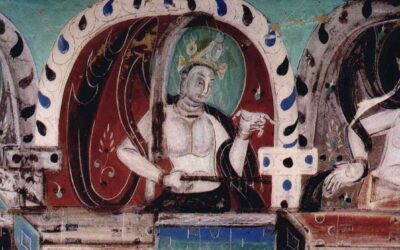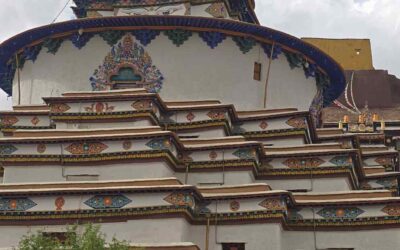The path to Nirvana in the Kunming Dharani Pillar
The main courtyard of the Kunming Municipal Museum houses one of the most original art-works from the time of the Dali Kingdom (937-1253 CE) in Yunnan. It is called the Dharani Pillar of the Dizang Temple. It is a stone pillar a little over six meters high, in the shape of a pagoda, on whose surface some of the most beautiful Buddhist sculptures of China have been carved. It is a pillar full of symbolism that shows a distinctive spiritual conception of the universe, in which Buddhist devotees are expected to find a path that leads from ignorance to enlightenment, in the transit between life and death, especially the general Gao, for whom it was built.
History of the dharani pillar
The history of the pillar is quite interesting. It was originally built at the beginning of the thirteenth century as a funerary monument for General Gao, a scion of one of the most prominent families of the time. Then it stood for centuries at the entrance of a Dizang temple established on the outskirts of Kunming. With the destruction of the temple in the late nineteenth century, the pillar remained, abandoned. A surviving monk from the old community obtained permission to make a quest to surround it with a fence. The disloyalty of a novice, who took off with the funds collected, forced the poor monk to go to the police. They took charge of the case and finished the fence in 1920. Later, the pillar formed part of the courtyard of a factory and part of a public garden, until a museum was built around it to correctly protect and exhibit it.
Unfortunately, although this monument occupies a prominent place in the history of the art of China and Southeast Asia, its existence goes unnoticed by most travellers. It is not usually mentioned in guidebooks or tourist brochures and a visit is not regularly included in the programs of travel agencies.
First researches on the Dharani Pillar
Though its existence is rarely highlighted in popular books, some academic studies published in recent decades provide scholarly circles with interesting insights about its value and significance. The pioneering study was carried out by Louis Finot and Victor Goloubew (“Le Fan-tseu t’a de Yunnanfou”) and published in the Bulletin de l’ Ecole Francaise d’ Extreme Orient in 1925. It is an introduction to the history of the pillar and a detailed description of its main elements, with identifications of the Buddhist sculptures and a discussion of their iconographic attributes.
The two articles written by Angela Falco Howard, an expert researcher in Chinese sculpture, are much more recent and important when it comes to assessing the role of this masterpiece in the Chinese and Asian sculpture of its time. In her first article (1996) she says that the pillar is a representative of the border culture of the Kingdom of Dali. She discovers influences that relate it to China, Tibet, India and the cultures of Southeast Asia. In the second article (1997), after a description of its most important elements, she focuses on identifying the main characters that took part in its creation. She frames the work in the Buddhist currents of the time, and stresses its distinctiveness with respect to other similar pillars found in China. She emphasizes that this is actually a funerary monument of the Bai ethnic group, which would reflect a world of beliefs different from those that could be found in the rest of China.
Given that these studies have hardly contributed to making this important monument known to the people, that many of their ideas can only be understood by readers with a basic knowledge of Yunnan history and Buddhist symbolism, and that the conditions for cultural diffusion have been greatly facilitated by the emergence of the digital world, we decided to take a few photographs of the monument and present them to the public with a few brief explanations, in the hope of helping to introduce this almost unknown masterpiece to those interested in Buddhism, Chinese culture and the arts in general.
The pillar in the Buddhist beliefs
We are convinced that the structure and elements of the pillar are much more than a magnificent work of art. When they are framed in the Buddhist beliefs of the time and in the artistic traditions of the Buddhist world, they will convey separate sets of secret communications that will appeal to sages, nobles and laymen, providing paths to enlightenment, transcendence and the salvation of the soul. When the study of this pillar is explained in the light the religion and politics of the ancient Yunnan, 800 years ago, it will reveal interesting aspects of the nature of the Kingdom of Dali, of its ruling elite and of the religion they practiced.
In this brief study my interest in culture is mixed, as in all of my books, with the desire to make it accessible and intelligible to a non-specialist reader. I wish to allow the many visitors that Kunming receives to value a magnificent work of art that usually goes unnoticed. Last, I hope to introduce to the general public the existence of this unique work, helping them to enter the complex symbolic world it shows.
To this end, we will try to make comprehensible its main elements and its rich symbolism, framing the pillar in the nature of the Buddhist constructions of the time and in the cultural and religious background of the Dali Kingdom. I will briefly describe the history of Yunnan at the time, the struggles for power among its elites. We will discuss the importance of religion as a factor of political legitimacy, both at the national level, the Kingdom of Dali against China and other countries, and at the local level, the Gao family against the Duan royal family.
The pillar as a road to Nirvana
We will show that in tune with the Buddhist tradition, the pillar proposes a path, a spiritual progression. We will identify for the readers the main deities present on it, and we will compare it with other religious constructions, whose shape, an ascending pyramid with well defined levels, is related. Similarities between the pillar and the imaginary constructions of mandalas and visualizations of Mount Meru will provide us with a deeper understanding of its religious value. Its references to complex sets of values will help to identify the environment in which it was erected, because only when one understands the culture of a country is one in a position to really appreciate its arts.
Ceinos-Arcones, Pedro. A Road to Nirvana. The Kunming Dharani pillar. Dancing Dragons Books. 2019
Last posts
Dunhuang in the Silk Road
Dunhuang in the Silk RoadDunhuang is a city in the middle of the desert. Over its 2,000-year history, it has always been the last Chinese outpost before reaching the Western Regions—those kingdoms more or less dominated by the imperial regimes, yet showing customs so...
Discover China’s Largest and Most Beautiful Salt Lake
Discover China’s Largest and Most Beautiful Salt Lake The development of tourism and transportation in China is bringing to light places that were previously very hard to access and virtually unknown. Some of these destinations are beginning to gain a certain...
A Giant Mandala in the Heart of Tibet
A Giant Mandala in the Heart of Tibet The Palkor of Gyantze is one of Tibet’s great marvels and a unique jewel of universal architecture and art. Its shape, scale, and iconography defy comparison with any other construction. Amidst some of the highest mountains of...







